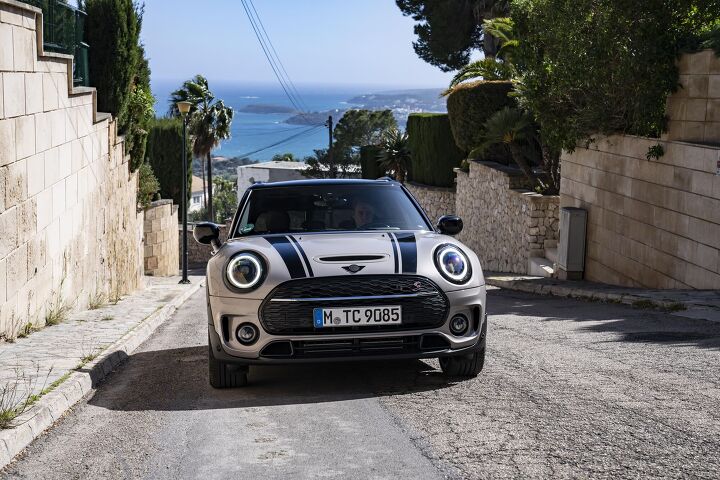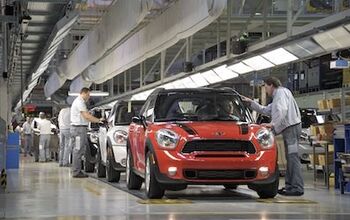Mini Ends Production of the Clubman

Production has officially ended on the Mini Clubman, with the automaker giving its farewell address for the model which saw nearly 21,000 deliveries inside the United States for 2023. While the brand isn’t known for trading in high volumes, Clubman deliveries have been hovering around 20,000 units for the last few years. That’s down from a peak of roughly 54,000 units in 2008.
Despite being a favorite among women wanting something unique and a little fun, the Clubman started a little higher than mainstream rivals and rarely offered comparable levels of practicality. It was really more of an alternative for people who wanted a Mini Cooper but fretted over the prospect of there not being sufficient interior space.
It’s also incredibly likely that the Clubman was being cannibalized by the Countryman or vice versa. While the latter is technically a little larger, a tad more expensive, and is configured more like an SUV, the cars are extremely similar from a practical standpoint. The only thing that’s really interesting about the duo is that Mini elected to keep the one that wasn’t selling as well. Our guess is that Mini is under the impression that would-be Clubman buyers will simply pivot to the Countryman or decide they can work with the smaller Cooper.
The automaker revealed the all-new Countryman (which includes an all-electric variant) earlier this year and the model seems to be moving closer toward SUV status. However, this has been the trend for most crossovers of late — which may also explain BMW Group’s hesitance to continue investing into the Mini Clubman.
However, Clubman faithful will eventually see the Aceman debut as basically an all-electric version of what the discontinued model would have probably evolved into. The assumption is that the Aceman will be slotted between electrified versions of the Cooper and Countryman with a price to match. But the concept version was likewise less wagon-like than the Clubman, making us a little worried that the Aceman might step on the toes of battery driven versions of the Countryman.
Either way, we’ll have to wait and see what actually shakes out of the factory. The Aceman hasn’t officially debuted yet and it’ll be some time before Mini spins up an assembly line for the new model. Meanwhile, Clubman production is officially over for good.
"We are incredibly proud to have built the Mini Clubman at Plants Oxford and Swindon over the last 18 years for customers all over the world," said Dr. Markus Gruneisl, CEO of the BMW-owned facilities located in Oxford and Swindon. "With its departure, we look ahead to welcoming members of the new MINI family to our Oxford and Swindon lines, including a new convertible model which we will start to produce at the end of this year."
[Images: BMW Group]
Become a TTAC insider. Get the latest news, features, TTAC takes, and everything else that gets to the truth about cars first by subscribing to our newsletter.

A staunch consumer advocate tracking industry trends and regulation. Before joining TTAC, Matt spent a decade working for marketing and research firms based in NYC. Clients included several of the world’s largest automakers, global tire brands, and aftermarket part suppliers. Dissatisfied with the corporate world and resentful of having to wear suits everyday, he pivoted to writing about cars. Since then, that man has become an ardent supporter of the right-to-repair movement, been interviewed on the auto industry by national radio broadcasts, driven more rental cars than anyone ever should, participated in amateur rallying events, and received the requisite minimum training as sanctioned by the SCCA. Handy with a wrench, Matt grew up surrounded by Detroit auto workers and managed to get a pizza delivery job before he was legally eligible. He later found himself driving box trucks through Manhattan, guaranteeing future sympathy for actual truckers. He continues to conduct research pertaining to the automotive sector as an independent contractor and has since moved back to his native Michigan, closer to where the cars are born. A contrarian, Matt claims to prefer understeer — stating that front and all-wheel drive vehicles cater best to his driving style.
More by Matt Posky
Latest Car Reviews
Read moreLatest Product Reviews
Read moreRecent Comments
- Olivehead The Honda Civic wins on looks and interior material quality and style. The Civic looks like a scaled down "real" car (i.e., midsize) while the Corolla never lets you forget what it is-a compact car, harkening back to the Tercel, etc. No comparision either in the interior materials of the Civic (a notch below Acura level) and general layout. There too, the Corolla comes off as a compact runabout. The Civic hatchback is especially cool.
- Mike Beranek While the product may appear to be "better", only time will tell. The American automotive environment can chew a car up and spit it out. Will these Chinese EVs survive like a quarter-century old Cavalier, or will they turn out like VinFast's "cars"?
- Mike Beranek This police vehicle will be perfect for when the State of Florida starts tracking every pregnancy.
- Dave M. The Highlander hybrid, a larger, heavier vehicle, gets better mpgs. Why? Also, missed opportunity - if Toyota had made this a hatchback, they could have scooped up the "want a Tesla S but not ready for a full EV" crowd, however small or large they may be....
- TheMrFreeze Difficult call...the more the mainstream automakers discontinue their more affordable models and only sell crazy overpriced EVs and trucks, the more appealing the idea of letting in cheap imported cars becomes with the buying public. If the government is going to impose tariffs on Chinese vehicles, at the same time they need to be getting with the Big 3 and telling them to fill the void with affordable models and not use the tariff as an excuse to simply raise prices. Otherwise, public pressure could see the tariffs withdrawn.I seem to recall the last administration put a 25% tariff on Chinese steel, at which point the US manufacturers immediately used the opportunity to raise their prices 25%...that needs to not happen.



































Comments
Join the conversation
Is anyone going to notice?
I already know what I'm going to call the Aceman.
Kramer!